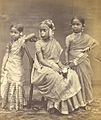Portal:Tamils
The Tamils portal
The Tamil people, also known as Tamilar (Tamil: தமிழர், romanized: Tamiḻar, pronounced [t̪amiɻaɾ] in the singular or தமிழர்கள், Tamiḻarkaḷ, [t̪amiɻaɾɡaɭ] in the plural), Tamilians, or simply Tamils (/ˈtæmɪlz, ˈtɑː-/ TAM-ilz, TAHM-), are a Dravidian ethnolinguistic group who natively speak the Tamil language and trace their ancestry mainly to India's southern state of Tamil Nadu, to the union territory of Puducherry, and to Sri Lanka. The Tamil language is one of the world's longest-surviving classical languages, with over 2000 years of Tamil literature, including the Sangam poems, which were composed between 300 BCE and 300 CE. People who speak Tamil as their mother tongue and are born in are considered Tamils.
Tamils constitute 5.9% of the population in India (concentrated mainly in Tamil Nadu and Puducherry), 15% in Sri Lanka (excluding Eelam Moors), 7% in Malaysia, and 5% in Singapore. From the 4th century BCE, urbanisation and mercantile activity along the western and eastern coasts of Tamilakam -- what is today Kerala and Tamil Nadu -- led to the development of four large Tamil empires, the Cheras, Cholas, Pandyas, Pallavas, and velirs and a number of smaller states, all of whom were warring amongst themselves for dominance. The Jaffna Kingdom, and vanni chieftaincies inhabited by Eelam Tamils, was once one of the strongest kingdoms of Sri Lanka and controlled much of the north of the island. (Full article...) Selected article -Tamil-Brahmi, also known as Tamili or Damili, was a variant of the Brahmi script in southern India. It was used to write inscriptions in the early form of Old Tamil. The Tamil-Brahmi script has been paleographically and stratigraphically dated between the third century BCE and the first century CE, and it constitutes the earliest known writing system evidenced in many parts of Tamil Nadu, Kerala, Andhra Pradesh and Sri Lanka. Tamil Brahmi inscriptions have been found on cave entrances, stone beds, potsherds, jar burials, coins, seals, and rings. Tamil Brahmi resembles but differs in several minor ways from the Brahmi inscriptions found elsewhere on the Indian subcontinent such as the Edicts of Ashoka found in Andhra Pradesh. It adds diacritics to several letters for sounds not found in Prakrit, producing ṉ ṟ ṛ ḷ. Secondly, in many of the inscriptions the inherent vowel has been discarded: A consonant written without diacritics represents the consonant alone, whereas the Ashokan diacritic for long ā is used for both ā and short a in Tamil-Brahmi. This is unique to Tamil-Brahmi and Bhattiprolu among the early Indian scripts. Tamil-Brahmi does not, however, share the odd forms of letters such as gh in Bhattiprolu. This appears to be an adaptation to Dravidian phonotactics, where words commonly end in consonants, as opposed to Prakrit, where this never occurs. According to Mahadevan, in the earliest stages of the script the inherent vowel was either abandoned, as above, or the bare consonant was ambiguous as to whether it implied a short a or not. Later stages of Tamil Brahmi returned to the inherent vowel that was the norm in ancient India. (Full article...)General imagesSelected biography - Velupillai Prabhakaran (listen (US English); Tamil: வேலுப்பிள்ளை பிரபாகரன்; [ˈʋeːlɯpːiɭːaɪ pɾaˈbaːhaɾan]; 26 November 1954 – 18 May 2009) was an Eelam Tamil revolutionary. Prabhakaran was a major figure of Tamil nationalism, and the founder and leader of the Liberation Tigers of Tamil Eelam (LTTE). The LTTE was a militant organization that sought to create an independent Tamil state in the north and east of Sri Lanka in reaction to the oppression of the country's Tamil population by the Sri Lankan government. Under his direction, the LTTE undertook a military campaign against the Sri Lankan government for more than 25 years. Prabhakaran was the youngest of four children, born in Valvettithurai, on Sri Lanka's Jaffna peninsula's northern coast. Considered the heart of Tamil culture and literature in Sri Lanka, Jaffna was concentrated with growing Tamil nationalism, which called for autonomy for Tamils to protest the discrimination against them by the Sinhalese-dominated Sri Lanka government and Sinhalese civilians since the country's independence from the United Kingdom in 1948. (Full article...)CategoriesTopicsTamil People Countrywide: India • Sri Lanka • Canada • Malaysia • Singapore • South Africa • England Related Ethnic Groups: Brahui • Gond • Kannadiga • Khonds • Kodava • Oraon • Malayali • Telugus • Tuluvas Related indigenous Groups: Badagas • Toda • Kuruba
See also: List of Tamil people, Tamil script, Tamil Script Code for Information Interchange Related portalsWikiProjectsThings to do
Associated WikimediaThe following Wikimedia Foundation sister projects provide more on this subject:
Discover Wikipedia using portals |































































